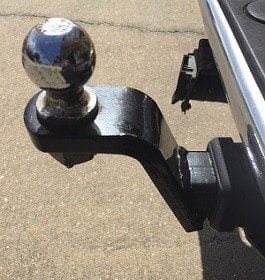 In a recent post, Stillman and Friedland shared valuable information about property damage and the value of your case. In it we discussed how, in most cases, insurance companies and juries relate injury compensation to the amount of damage to the vehicle. The assumption is that the more damage there is to the car, the more damage there is to the passengers. Today we are going to talk about a big exception to the rule, rear-end collisions when the impacted vehicle has a trailer hitch. Trailer hitches are more and more common these days, especially on light trucks and SUVs.
In a recent post, Stillman and Friedland shared valuable information about property damage and the value of your case. In it we discussed how, in most cases, insurance companies and juries relate injury compensation to the amount of damage to the vehicle. The assumption is that the more damage there is to the car, the more damage there is to the passengers. Today we are going to talk about a big exception to the rule, rear-end collisions when the impacted vehicle has a trailer hitch. Trailer hitches are more and more common these days, especially on light trucks and SUVs.
The trend now is to add a trailer hitch which projects beyond the rear profile of the vehicle; this kind of hitch is even standard on the Chevy Blazer, for example. The big benefit of a projecting hitch is that it absorbs the first impact, and minimizes or eliminates direct impact with the car itself. Instead of smashing your bumper or breaking your rear window, the hitch takes the impact. It works very well to minimize vehicle damage, especially since most rear-end impacts occur at 10 M.P.H. or less.
Here is the problem: While the hitch minimizes vehicle damage, it increases the severity of whiplash injuries to the passenger, because it is not shock-absorbent. According to the National Safety Commission, hitches generate a “crash pulse” which accelerates them forward at 2.5 times the rate of motion of the impacting vehicle. The chance of suffering a whiplash injury then increases by 22%. Women and children are especially vulnerable, but men are also affected.
As we have noted many times before, it is difficult to prove injury in soft tissue injuries which neither show up on x-rays, nor cause visible lacerations or burns. A key part of proving this kind of injury is seeking immediate treatment if you have suffered an impact. While Stillman and Friedland’s attorneys are experienced in handling this kind of case, a delay in treatment makes these cases more difficult to prove.
As always, we prefer prevention over treatment. Most people use their hitches less than 1% of the time. However, low-impact, rear-end collisions which can cause severe whiplash due to trailer hitches are common accidents. They can happen in any parking lot or at a stop light. Prevention options are:
• Remove the hitch
• Install a hitch which has a shock absorbing mechanism built in
Whichever option you choose to solve your trailer hitch problem, if you have suffered a rear-end collision; Stillman and Friedland is the firm for excellent, compassionate handing of your accident case.
Because we care…






